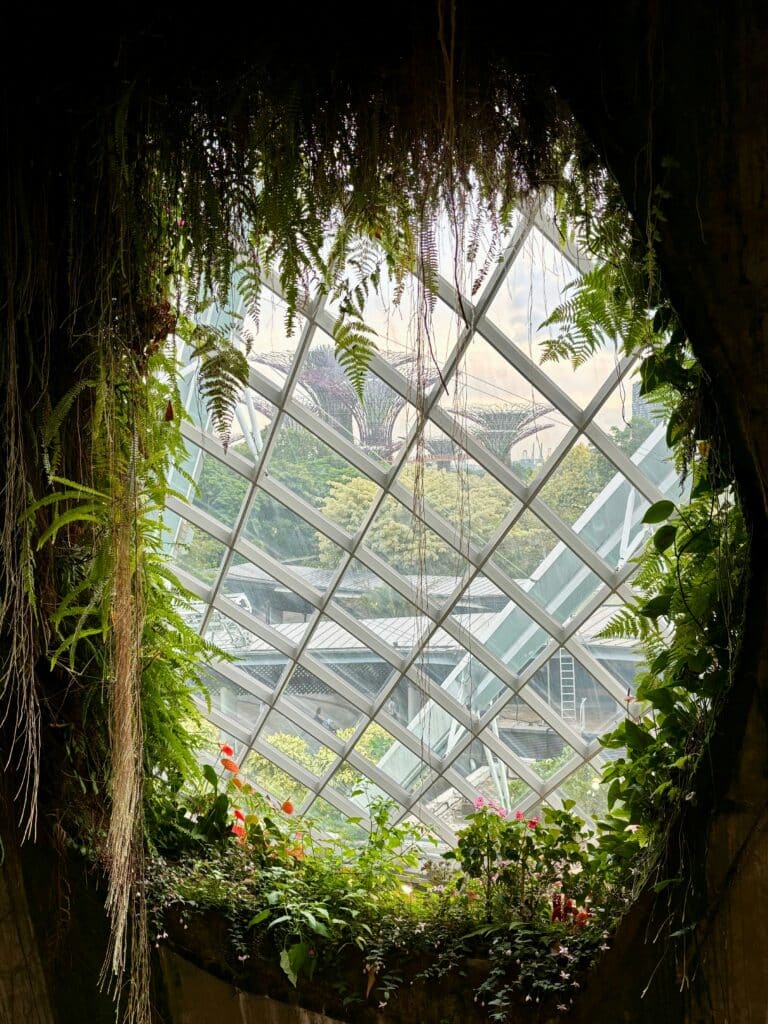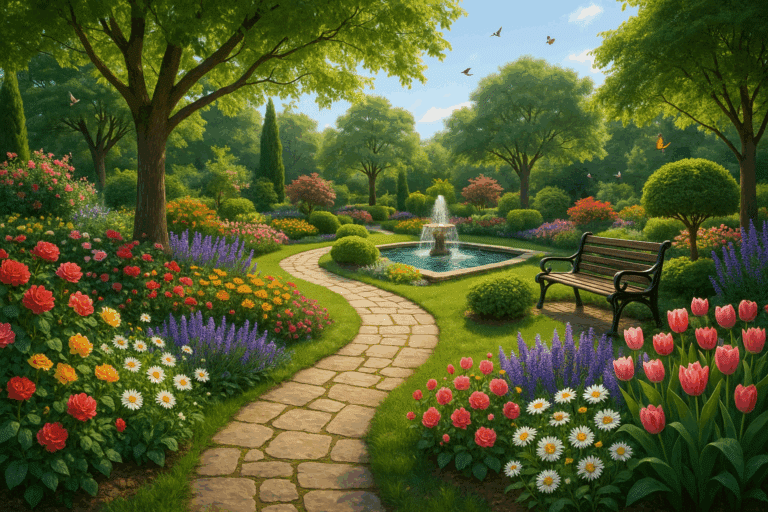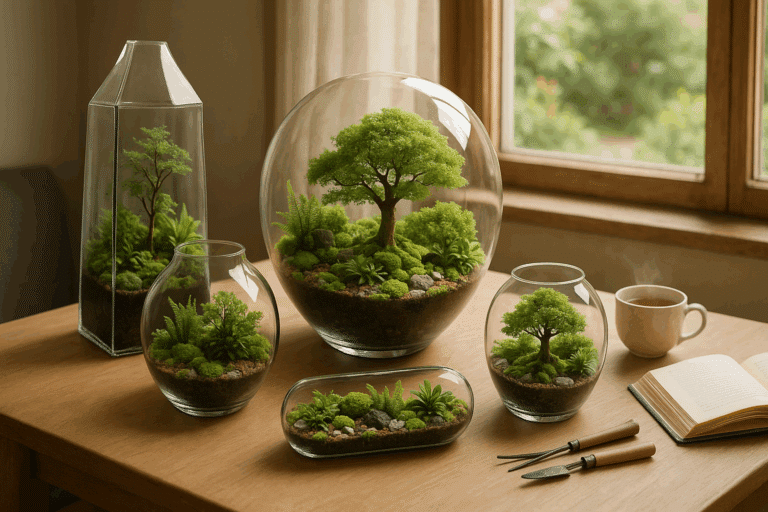This serene yet vibrant world echoes the raw, natural beauty of our very own planet, offering an exquisite escape into a miniature oasis. There’s an enchanting adventure that awaits you, nestled within the intricate layers of vibrant flora, bathed in the soft, dappled sunlight that filters through the glass.
In the heart of every bustling city, amidst the concrete jungle, these glass terrariums stand as an emblem of tranquility and natural allure. With their vivid foliage and petite charm, these miniature landscapes capture the essence of vast forests, dense jungles, and tranquil meadows. The compelling allure of these living, breathing artworks is hard to resist, promising an enchanting journey into the heart of nature’s splendor.

The following pages will unravel the mysteries hidden in these compact ecosystems, guiding you through their verdant pathways. We’ll explore the fascinating process of creating these miniatures, from selecting the right plants to their placement within the glass enclosures. We’ll delve into the captivating science behind these self-sustaining ecosystems and share tips on their maintenance.
Indulge in the beauty of these green oases, and let the allure of these verdant paradises captivate you. Discover the charm of these glass terrariums, and let this guide help you step into the mesmerizing world of miniature jungles. The beauty of nature, condensed into a glass sphere, awaits your exploration.
The Science Behind the Green: Building and Sustaining Your Glass Terrarium Jungle
To truly appreciate the beauty of a glass terrarium jungle, one must first explore the science that makes these self-contained ecosystems possible. These miniature green worlds are more than trendy decor pieces—they are living demonstrations of ecological balance, plant biology, and artistic harmony. A terrarium mimics Earth’s natural systems in a transparent vessel, offering a glimpse into how life sustains itself when given the right conditions.
In this comprehensive guide, we’ll walk through the scientific principles behind terrariums, how to build one, the best plants to choose, and how to maintain their health and beauty over time. We’ll also dive into common issues, advanced tips, and how these green oases contribute to your emotional well-being.
Why Glass?
Glass plays a significant role in this ecosystem. It not only provides a clear and unhindered view of the plants but also creates the right conditions for them to thrive. Glass allows light to penetrate while trapping heat, creating a mini greenhouse effect. This microclimate is ideal for tropical plants that thrive in humid conditions.
Understanding the Self-Sustaining Ecosystem
A terrarium functions on the same principles that govern our planet’s ecosystems—chiefly the water cycle and photosynthesis.
The Water Cycle in a Jar
In a closed terrarium, the moisture from the soil and plants evaporates due to warmth (often from sunlight or ambient indoor heat). It then condenses on the cool walls of the glass and drips back into the soil—just like rain. This hydrological loop ensures that the plants remain hydrated without regular watering.
Photosynthesis and Respiration
Plants inside the terrarium absorb carbon dioxide during the day and release oxygen through photosynthesis. At night, they reverse the process—consuming oxygen and releasing carbon dioxide. If well-balanced, this cycle creates a stable atmosphere for plant life. The presence of moss or slow-growing ferns helps regulate this exchange effectively.
Why Glass Makes All the Difference
The glass container plays a crucial role in enabling this microclimate. It offers:
- Transparency, allowing light to penetrate for photosynthesis
- Humidity retention, essential for tropical plants
- Insulation, protecting the ecosystem from sudden temperature changes
- Visibility, turning the terrarium into a piece of living art
While alternatives like acrylic exist, glass remains the gold standard for clarity, durability, and temperature regulation.
Creating Your Own Miniature Jungle
Building a terrarium is an act of creativity and science. Here’s a step-by-step guide:
1. Choosing the Right Vessel
You can use a wide variety of containers—from mason jars and fishbowls to apothecary jars and geometric glass orbs. The container type affects plant choice and maintenance:
- Closed terrariums (sealed lids) are ideal for humidity-loving tropical plants.
- Open terrariums (open tops) suit succulents and cacti that prefer drier conditions.
Make sure your container is clean and clear of debris before beginning.
2. Assembling the Layers
A healthy terrarium requires well-planned layers:
- Drainage layer – Pebbles or gravel at the bottom prevent water from pooling in the soil and causing root rot.
- Activated charcoal – This filters impurities and odors, especially in closed systems.
- Sphagnum moss – Acts as a sponge and barrier, preventing the soil from slipping into the drainage layer.
- Potting soil – Lightweight soil for tropicals; cactus mix for succulents.
- Plants and decorations – Carefully placed to balance scale, color, and function.
These layers replicate the structure of forest floors, where drainage and decomposition are vital to plant health.
Selecting the Right Plants
Not all plants thrive in terrariums. The best choices share key traits: slow growth, love for humidity, and compact root systems.
Ideal Plants for Closed Terrariums
- Ferns (e.g., maidenhair, button fern)
- Fittonia (nerve plant)
- Mosses (sheet moss, cushion moss)
- Peperomia
- Pilea
- Miniature orchids
- Calathea
These plants prefer consistent humidity and indirect light—perfect for sealed environments.
For Open Terrariums
- Echeveria
- Haworthia
- Air plants (Tillandsia)
- Jade plant
- Sedum
These require dry air and excellent airflow—best left unsealed.
Avoid mixing incompatible species (e.g., combining succulents with tropicals) to ensure longevity.
Building the Layers
A terrarium typically consists of multiple layers. The bottom layer, or the drainage layer, is made of small pebbles or gravel to allow excess water to drain. The next layer is activated charcoal, which purifies the water and prevents bacterial growth. The third layer is sphagnum moss, which acts as a barrier to prevent the soil from falling into the lower layers. The final layer is the potting soil where your plants will grow.
Arranging Your Plants
Design isn’t just about beauty—it’s about function:
- Taller plants should be placed toward the back or center.
- Shorter plants and moss fill the foreground and edges.
- Leave space between plants for air circulation.
- Use tweezers or chopsticks for precision.
Consider visual depth by layering materials or adding slopes, and balance your palette with light and dark greens, textures, and occasional pops of color.
Maintaining Your Glass Terrarium Jungle
A well-maintained terrarium can last years—even decades.
Light
Place your terrarium in a spot that receives bright, indirect light. Avoid direct sun, which can overheat the interior and scorch leaves. LED grow lights are also a safe alternative in low-light homes.
Watering
- For closed terrariums: Water sparingly (about once every 3–4 weeks). Look for condensation as a good sign.
- For open terrariums: Water more often (weekly), but avoid soaking.
- Always use filtered or rainwater to prevent mineral buildup.
Pruning and Cleaning
Clean glass walls regularly with a damp cloth. Avoid harsh chemicals.
Trim overgrown plants to prevent overcrowding.
Remove decaying leaves to avoid mold.
The Artistic Value of Glass Terrarium Jungle
A glass terrarium jungle is not only a testament to the wonders of nature and science, but also a unique piece of art. With careful plant selection and arrangement, you can create a miniature landscape that brings the lush green beauty of a jungle right into your living room.
Artistic and Emotional Expression
Beyond the science, terrariums are living art forms. They allow you to sculpt nature on a miniature scale, infusing your space with texture, life, and story.
Additions for Creativity
- Mini figurines (dinosaurs, forest creatures, or people)
- Fairy lights for magical ambience
- Natural objects like driftwood, crystals, or bones
- Color themes (all green, jewel tones, pastels)
Playing with Perspective
- Use foreground/background contrasts to simulate depth.
- Layer terrain with hills and valleys using extra soil.
- Create scenes (e.g., forest trail, tropical ruin, moon garden).
Your terrarium becomes a conversation piece—a glimpse into your personality.
Wellness and Emotional Benefits
Caring for a terrarium is not just about aesthetics or botany—it’s a therapeutic activity that fosters calm, mindfulness, and satisfaction.
Emotional Advantages

- Reduces stress and anxiety
- Encourages patience and presence
- Offers a sense of nurturing and growth
- Boosts mood through exposure to greenery
- Creates beauty in even the smallest apartment or office
Terrariums bring the outdoors inside, offering the serenity of nature even in the densest urban setting. Watching your miniature ecosystem flourish is deeply rewarding and grounding.
Terrarium Variations to Explore
Once you’ve mastered the basics, try new themes and styles:
- Desertscape Terrarium – Open container with sand, succulents, and dry textures.
- Forest Floor Terrarium – Use bark, mushrooms, mosses, and shade plants.
- Aquaterrarium – Add a water feature or semi-aquatic plants.
- Hanging Terrariums – Glass orbs suspended in windows or from ceiling hooks.
- Wall Terrariums – Mounted glass pods for vertical gardens.
Each style invites different techniques and sparks new creativity.
Incorporating Design Elements
You can incorporate various design elements to enhance the aesthetic appeal of your terrarium, transforming it from a simple container of plants into a storytelling environment. For instance, miniature figurines—such as tiny forest creatures, fairies, animals, or explorers—can create a narrative within the space, inviting the viewer to imagine a world beyond the glass.
Use colored pebbles to craft meandering paths, simulate rivers, or mark territory boundaries. Contrasting colors and textures—like smooth white stones next to velvety green moss—offer visual intrigue and help delineate areas within your terrarium’s landscape.
Additionally, consider adding:
- Natural elements like bark chips, crystals, or driftwood for texture and earthy appeal
- Tiny furniture (benches, bridges, or swings) for a whimsical effect
- Lighting—small LED fairy lights can create a magical atmosphere, especially in evening displays
- Thematic layers, such as a Zen garden, rainforest floor, or enchanted forest, to reflect mood or season
These design choices not only personalize your terrarium, but they also reflect your inner world—making each one unique and expressive.
Conclusion: A Jungle in Your Hands
The beauty of a glass terrarium jungle lies in its simplicity, resilience, and mystery. It’s a living, breathing world that grows with you, teaching care, balance, and artistry in each step.
You’re not just assembling a decor piece—you’re crafting a living poem made of moss, leaves, and condensation. These glass ecosystems remind us that life thrives even in the smallest spaces, and with attention and wonder, we can participate in something truly natural and deeply meaningful.
So gather your plants, choose your vessel, and start your jungle today. Let it be a testament to your creativity, curiosity, and care for the green world.
Conclusion
Playing with scale can create a sense of depth and intrigue in your terrarium. You can use smaller plants in the background and larger ones in the foreground to create an illusion of distance. Similarly, placing taller plants at the back and shorter ones at the front can give a sense of height and dimension.
In conclusion, the enchanting world of Glass Terrarium Jungle provides an oasis of natural beauty in miniature form. This lush green realm encapsulates the essence of the wild, offering a unique way to interact with nature right within our homes or workplaces. This is more than a mere hobby; it’s a lifestyle, a commitment to promoting environmental awareness, and a creative means of self-expression.
This thriving glass ecosystem serves as a remarkable testimony to the resilience and diversity of plant life, fitting into our urban lives perfectly. Through this green endeavor, not only do we get to contribute to the environment, but we also cultivate patience, creativity, and a sense of tranquility.
From creating your own terrarium jungle, choosing the right plants, taking care of them, to witnessing them thrive, the process is an invigorating journey that connects us with nature. As each terrarium is unique, they are also excellent conversation starters, adding a touch of personality to your space.
So, whether you’re a seasoned gardener or just starting, the glass terrarium jungle offers endless possibilities. So why wait? Step into this lush green world and let nature take the lead. Embrace the miniature oasis of natural beauty that awaits you in the Glass Terrarium Jungle.
Remember, every journey starts with a single step, and your journey into this verdant paradise is no exception. Your own little glass jungle awaits, so step in and immerse yourself in the tranquility it offers.



